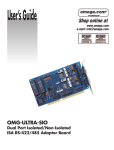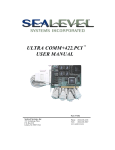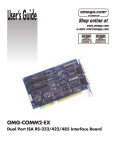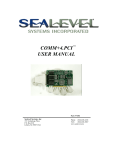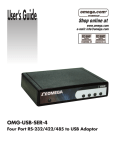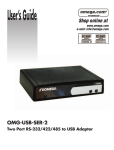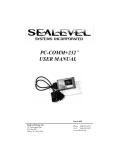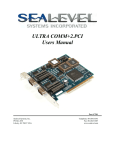Download Omega Engineering RS-422/485 Network Router User Manual
Transcript
User’s Guide Shop online at www.omega.com e-mail: [email protected] OMG-ULTRACOMM422 Automatic Four Port ISA RS-422/485 Interface Board OMEGAnet ® Online Service www.omega.com Internet e-mail [email protected] Servicing North America: USA: ISO 9001 Certified Canada: One Omega Drive, P.O. Box 4047 Stamford CT 06907-0047 TEL: (203) 359-1660 e-mail: [email protected] 976 Bergar Laval (Quebec) H7L 5A1, Canada TEL: (514) 856-6928 e-mail: [email protected] FAX: (203) 359-7700 FAX: (514) 856-6886 For immediate technical or application assistance: USA and Canada: Sales Service: 1-800-826-6342 / 1-800-TC-OMEGA® Customer Service: 1-800-622-2378 / 1-800-622-BEST® Engineering Service: 1-800-872-9436 / 1-800-USA-WHEN® TELEX: 996404 EASYLINK: 62968934 CABLE: OMEGA Mexico: En Espan˜ol: (001) 203-359-7803 FAX: (001) 203-359-7807 e-mail: [email protected] [email protected] Servicing Europe: Benelux: Postbus 8034, 1180 LA Amstelveen, The Netherlands TEL: +31 (0)20 3472121 FAX: +31 (0)20 6434643 Toll Free in Benelux: 0800 0993344 e-mail: [email protected] Czech Republic: Frystatska 184, 733 01 Karviná, Czech Republic TEL: +420 (0)59 6311899 FAX: +420 (0)59 6311114 Toll Free: 0800-1-66342 e-mail: [email protected] France: 11, rue Jacques Cartier, 78280 Guyancourt, France TEL: +33 (0)1 61 37 29 00 FAX: +33 (0)1 30 57 54 27 Toll Free in France: 0800 466 342 e-mail: [email protected] Germany/Austria: Daimlerstrasse 26, D-75392 Deckenpfronn, Germany TEL: +49 (0)7056 9398-0 Toll Free in Germany: 0800 639 7678 e-mail: [email protected] United Kingdom: ISO 9002 Certified FAX: +49 (0)7056 9398-29 One Omega Drive, River Bend Technology Centre Northbank, Irlam, Manchester M44 5BD United Kingdom TEL: +44 (0)161 777 6611 FAX: +44 (0)161 777 6622 Toll Free in United Kingdom: 0800-488-488 e-mail: [email protected] It is the policy of OMEGA to comply with all worldwide safety and EMC/EMI regulations that apply. OMEGA is constantly pursuing certification of its products to the European New Approach Directives. OMEGA will add the CE mark to every appropriate device upon certification. The information contained in this document is believed to be correct, but OMEGA Engineering, Inc. accepts no liability for any errors it contains, and reserves the right to alter specifications without notice. WARNING: These products are not designed for use in, and should not be used for, patient-connected applications. Contents INTRODUCTION..........................................................................1 OVERVIEW................................................................................................ 1 W HAT ’S INCLUDED ................................................................................ 1 FACTORY DEFAULT SETTINGS ............................................................ 1 CARD SETUP ..............................................................................2 A DDRESS SELECTION............................................................................. 2 JUMPER SELECTIONS............................................................................. 4 IRQ Selection........................................................................................ 4 INTERRUPT M ODES................................................................................ 5 RS-485 ENABLE M ODES......................................................................... 6 Interface Mode Examples J1D – J4D................................................. 7 Interface Mode Examples J1D – J4D (continued)........................... 8 LINE TERMINATION ............................................................................... 9 CLOCK M ODES ...................................................................................... 10 BAUD RATES AND DIVISORS FOR THE ‘DIV1’ MODE ...................... 11 BAUD RATES AND DIVISORS FOR THE ‘DIV2’ MODE ...................... 12 INSTALLATION ........................................................................13 OPERATING SYSTEM INSTALLATION ............................................... 13 For Windows Users .......................................................................... 13 Other Operating Systems ................................................................. 13 TECHNICAL DESCRIPTION .......................................................14 FEATURES .............................................................................................. 14 INTERRUPTS .......................................................................................... 15 W HY USE AN ISP?................................................................................. 16 CONNECTOR PIN A SSIGNMENTS........................................................ 17 DB-9 Pin Assignments...................................................................... 17 DB-37 Connector Pin Assignments ................................................ 17 SPECIFICATIONS ......................................................................18 ENVIRONMENTAL SPECIFICATIONS.................................................. 18 M ANUFACTURING ................................................................................ 18 POWER CONSUMPTION........................................................................ 18 M EAN TIME BETWEEN FAILURES (MTBF) ..................................... 18 PHYSICAL DIMENSIONS........................................................................ 18 APPENDIX A - TROUBLESHOOTING .........................................19 APPENDIX B - HOW TO GET ASSISTANCEERROR! BOOKMARK NOT DEFINED. APPENDIX C - ELECTRICAL INTERFACE...................................22 RS-422..................................................................................................... 22 RS-485..................................................................................................... 22 APPENDIX D - ASYNCHRONOUS COMMUNICATIONS ...............23 APPENDIX E - SILK-SCREEN ....................................................24 APPENDIX F - COMPLIANCE NOTICES .....................................25 FEDERAL COMMUNICATIONS COMMISSION STATEMENT ............ 25 EMC DIRECTIVE STATEMENT ........................................................... 25 Figures Figure 1 - Available Address Combinations......................................................2 Figure 2 - Address Selection Table ....................................................................3 Figure 3 - Port to Connector Table.....................................................................3 Figure 4 - Header J1A, Normal IRQ Mode........................................................5 Figure 5 - Header J1A & J2A, Shared IRQ Mode ...........................................5 Figure 6- Headers J1D- J4D, RS-422................................................................7 Figure 7 - Headers J1D- J4D, RS-485 ‘Auto’ Enabled, with ‘No Echo’ .......7 Figure 8 - Headers J1D- J4D, RS-485 ‘Auto’ Enabled, with ‘Echo’ .............7 Figure 9 - Headers J1D- J4D, RS-485 ‘RTS’ Enabled, with ‘No Echo’........8 Figure 10 - Headers J1D- J4D, RS-485 ‘RTS’ Enabled, with ‘Echo’ ...........8 Figure 11 - Headers J1E - J4E, Line Termination...........................................9 Figure 12 - Clocking Mode 'Divide By 4’........................................................10 Figure 13 - Clocking Mode 'Divide By 2’........................................................10 Figure 14 - Clocking Mode 'Divide By 1’........................................................10 Figure 15 - Asynchronous Communications Bit Diagram ..........................23 Introduction Introduction Overview The OMG-ULTRA-COMM422 provides the PC with four additional RS-422/485 serial ports for terminals, modems, printers, etc. The unique feature of the OMG-ULTRA-COMM422 is the ability to be RS-485 compatible without the need for special software or drivers. This ability is especially useful in Windows, Windows NT, and OS/2 environments where the lower level I/O control is abstracted from the application program. This ability means that the user can effectively use the OMG-ULTRA-COMM422 in an RS485 application with existing (i.e. standard RS-232) software drivers. Note: The ‘Auto Enable’ feature is not available on the p/n 3441. What’s Included The OMG-ULTRA-COMM422 is shipped with the following items. If any of these items are missing or damaged, contact the supplier. • • • OMG-ULTRA-COMM422 Serial I/O Adapter DB-37 to four DB-9 ‘Spider Cable’ Software Factory Default Settings The OMG-ULTRA-COMM422 factory default settings are as follows: Port # Port 1 Port 2 Port 3 Port 4 Base Address 280 288 290 298 IRQ 10 5 10 5 Electrical Specification RS-422 RS-422 RS-422 RS-422 To install the OMG-ULTRA-COMM422 using factory default settings, refer to Installation on page 13. For your reference, record installed OMG-ULTRA-COMM422 settings below: Port # Port 1 Port 2 Port 3 Port 4 Base Address OMG-ULTRA-COMM422 IRQ Electrical Specification Page 1 Card Setup Card Setup The OMG-ULTRA-COMM422 contains several jumper straps, which must be set for proper operation. Address Selection Each port on the OMG-ULTRA-COMM422 occupies eight consecutive I/O locations. A DIP-switch is used to set the base address for these locations. The OMG-ULTRA-COMM422 has a unique addressing scheme that allows it to be completely compatible with older four port RS-422/485 interface adapter (p/n 3067) and provide for the ability to select address combinations more commonly used. The first addressing scheme allows the OMG-ULTRA-COMM422 to select the addresses for its ports from a table of available address combinations. The following table shows the addressing combinations available. If different address combinations are required, please contact Technical Support about a custom PAL option. Switch 6 On On On Off Off Off Off On Switch 7 On Off Off On On Off Off On Switch 8 Off On Off On Off On Off On Port Port Port Port 1 2 3 4 3F8 2F8 3E8 2E8 2F8 3E8 2E8 2E0 3E8 2E8 280 288 500 508 510 518 580 588 590 598 1500 1508 1510 1518 3220 3228 4220 4228 Addresses set up by switches 1-5 Figure 1 - Available Address Combinations Note: Each COM: port in the system should have a unique address. Typically COM1: - COM4: addresses are 3F8, 2F8, 3E8 and 2E8 Hex. Refer to Appendix A for common address contentions. OMG-ULTRA-COMM422 Page 2 Card Setup The second mode of address selection provides the compatibility mode. In this mode the DIP-switch sets the base address and the adapter occupies 32 consecutive I/O locations. The following table illustrates the location of each port and its relationship to the other ports. Note: For switches 1 - 5 to become active, switches 6, 7 & 8 must be set in the ‘On’ or ‘Up’ position. Address lines à Address Selected 280-29F 2A0-2BF 380-39F 1A0-1BF 2E0-2FF A9 1 Off Off Off On Off Switch Settings A8 A7 A6 2 3 4 On Off On On Off On Off Off On Off Off On On Off Off A5 5 On Off On Off Off Figure 2 - Address Selection Table The following illustration shows the correlation between the DIP-switch setting and the address bits used to determine the base address. In the example below, address 2E0 is selected as a base. Address 2E0 in binary is XX 10 111X XXXX where X = a non-selectable address bit. A9 A5 ON OFF Port # 1 2 3 4 1 2 3 4 5 6 7 8 Connector Location 1 2 3 4 Address Base+0 Base+8 Base+16 Base+24 Example (Base=2E0) 2E0-2E7 2E8-2EF 2F0-2F7 2F8-2FF Figure 3 - Port to Connector Table OMG-ULTRA-COMM422 Page 3 Card Setup Jumper Selections For ease of configuration, the headers are grouped by port. Port one headers have a ‘J1’ prefix; Port two headers have the ‘J2’ prefix, etc. For example, the header that controls the Port one IRQ selection is J1B; the header that controls the Port 2 IRQ selection is J2B. The silk-screen also provides information for configuring the adapter without the use of the manual. This is particularly useful in field re-configuration. IRQ Selection Headers J1B through J4B select the interrupt request for each serial port. If COM1: is selected, the corresponding jumper must be on the IRQ4 setting. If COM2: is selected, the corresponding jumper must be on IRQ3. 3 4 5 6 7 9 10 11 12 15 Figure 4 – Headers J1B – J4B, IRQ Selection Note: Most communications software applications default COM3: to IRQ4 and COM4: to IRQ3. This requires the sharing of interrupts between COM1: and COM3:, and between COM2: and COM4:. While this is the default, it is not always the preferred setting. Check your software configuration instructions to determine the most appropriate IRQ selection. Any two or more ports can share a common IRQ by placing the jumpers on the same IRQ setting and setting the appropriate selections at J1A through J4A. Consult your particular software for IRQ selection. If no interrupt is desired, remove the jumper. OMG-ULTRA-COMM422 Page 4 Card Setup Interrupt Modes Headers J1A through J4A select the interrupt modes for each port. Each port must be set in the correct mode to insure proper operation. ‘N’ indicates the (N)ormal, single interrupt per port mode. ‘S’ Indicates the (S)hared interrupt mode, which allows more than one port to access a single IRQ. ‘M’ indicates the inclusion of a 1K ohm pull-down resistor required on one port when sharing interrupts. J1A N S M Figure 4 - Header J1A, Normal IRQ Mode Set the jumpers to ‘S’ for shared interrupt mode on all blocks sharing an IRQ except one. Set that port block for ‘M’. This provides the pull-down resistor circuit that makes sharing IRQs possible. If you are using more than one OMGULTRA-COMM422 or a compatible adapter in a bus you should only have one port set to ‘M’. The following example shows two ports sharing a single IRQ. J1A N S M J2A N S M Figure 5 - Header J1A & J2A, Shared IRQ Mode Set the jumper to ‘S’ if you are using more than one OMG-ULTRA-COMM422 in a bus or to completely remove the pull-down resistor for hardware compatibility. Setting the adapter in this configuration when it is not accompanied by a pulldown resistor will prevent the ports from triggering an interrupt. OMG-ULTRA-COMM422 Page 5 Card Setup RS-485 Enable Modes RS-485 is ideal for multi-drop or network environments. RS-485 requires a tri-state driver (not dual-state) that will allow the electrical presence of the driver to be removed from the line. The driver is in a tri-state or high impedance condition when this occurs. Only one driver may be active at a time and the other driver(s) must be tri-stated. The output modem control signal Request To Send (RTS) is typically used to control the state of the driver. Some communication software packages refer to RS-485 as RTS enable or RTS block mode transfer. One of the unique features of the OMG-ULTRA-COMM422 is the ability to be RS-485 compatible without the need for special software or drivers. This ability is especially useful in Windows, Windows NT, and OS/2 environments where the lower level I/O control is abstracted from the application program. This ability means that the user can effectively use the OMG-ULTRA-COMM422 in an RS485 application with existing (i.e. standard RS-232) software drivers. Headers J1D through J4D are used to control the RS-485 mode functions for the driver circuit. The selections are ‘RTS’ enable (silk-screen ‘RT’) or ‘Auto’ enable (silk-screen ‘AT’). The ‘Auto’ enable feature automatically enables/disables the RS-485 interface. The ‘RTS’ mode uses the ‘RTS’ modem control signal to enable the RS-485 interface and provides backward compatibility with existing software products. Position 3 (silk-screen ‘NE’) of J1D through J4D is used to control the RS-485 enable/disable functions for the receiver circuit and determine the state of the RS-422/485 driver. The RS-485 ‘Echo’ is the result of connecting the receiver inputs to the transmitter outputs. Every time a character is transmitted, it is also received. This can be beneficial if the software can handle echoing (i.e. using received characters to throttle the transmitter) or it can confuse the system if the software does not. To select the ‘No Echo’ mode select silk-screen position ‘NE’. For RS-422/530/449 compatibility remove the jumpers at J1D through J4D. Examples on the following pages describe all of the valid settings for J1D - J4D. OMG-ULTRA-COMM422 Page 6 Card Setup AT RT NE Interface Mode Examples J1D – J4D AT RT NE Figure 6- Headers J1D- J4D, RS-422 AT RT NE Figure 7 - Headers J1D- J4D, RS-485 ‘Auto’ Enabled, with ‘No Echo’ Figure 8 - Headers J1D- J4D, RS-485 ‘Auto’ Enabled, with ‘Echo’ OMG-ULTRA-COMM422 Page 7 Card Setup AT RT NE Interface Mode Examples J1D – J4D (continued) AT RT NE Figure 9 - Headers J1D- J4D, RS-485 ‘RTS’ Enabled, with ‘No Echo’ Figure 10 - Headers J1D- J4D, RS-485 ‘RTS’ Enabled, with ‘Echo’ OMG-ULTRA-COMM422 Page 8 Card Setup Line Termination Typically, each end of the RS-485 bus must have line terminating resistors (RS-422 terminates at the receive end only). A 120-ohm resistor is across each RS-530/422/485 input in addition to a 1K ohm pull-up/pull-down combination that bias the receiver inputs. Headers J1E through J4E allow the user to customize this interface to their specific requirements. Each jumper position corresponds to a specific portion of the interface. If multiple OMG-ULTRA-COMM422 adapters are configured in an RS-485 network, only the boards on each end should have jumpers T, P & P ON. Refer to the following table for each position’s operation: Name P P T L L Function Adds or removes the 1K ohm pull-down resistor in the RS-422/RS-485 receiver circuit (Receive data only). Adds or removes the 1K ohm pull-up resistor in the RS-422/RS485 receiver circuit (Receive data only). Adds or removes the 120 ohm termination. Connects the TX- to RX- for RS-485 two wire operation. Connects the TX+ to RX+ for RS-485 two wire operation. P P T L L Figure 11 - Headers J1E - J4E, Line Termination OMG-ULTRA-COMM422 Page 9 Card Setup Clock Modes The OMG-ULTRA-COMM422 employs a unique clocking option that allows the end user to select from divide by 4, divide by 2 and divide by 1 clocking modes. These modes are selected at Headers J1C through J4C. DIV1 DIV2 DIV4 To select the Baud rates commonly associated with COM: ports (i.e. 2400, 4800, 9600, 19.2, … 115.2K Bps ) place the jumper in the divide by 4 mode (silk-screen DIV4). Figure 12 - Clocking Mode 'Divide By 4’ DIV1 DIV2 DIV4 To double these rates up to a maximum rate for 230.4K bps place the jumper in the divide by 2 (silk-screen DIV2) position. Figure 13 - Clocking Mode 'Divide By 2’ DIV1 DIV2 DIV4 To select the maximum data rate (460.8K bps) place the jumper in the divide by 1 (silk-screen DIV1) position. Figure 14 - Clocking Mode 'Divide By 1’ OMG-ULTRA-COMM422 Page 10 Card Setup Baud Rates and Divisors for the ‘Div1’ mode The following table shows some common data rates and the rates you should choose to match them if using the adapter in the ‘Div1’ mode. For this Data Rate 1200 bps 2400 bps 4800 bps 9600 bps 19.2K bps 57.6 K bps 115.2 K bps 230.4K bps 460.8K bps Choose this Data Rate 300 bps 600 bps 1200 bps 2400 bps 4800 bps 14.4K bps 28.8K bps 57.6 K bps 115.2 K bps If your communications package allows the use of Baud rate divisors, choose the appropriate divisor from the following table: For this Data Rate 1200 bps 2400 bps 4800 bps 9600 bps 19.2K bps 38.4K bps 57.6K bps 115.2K bps 230.4K bps 460.8K bps OMG-ULTRA-COMM422 Choose this Divisor 384 192 96 48 24 12 8 4 2 1 Page 11 Card Setup Baud Rates and Divisors for the ‘Div2’ mode The following table shows some common data rates and the rates you should choose to match them if using the adapter in the ‘Div2’ mode. For this Data Rate 1200 bps 2400 bps 4800 bps 9600 bps 19.2K bps 38.4K bps 57.6 K bps 115.2 K bps 230.4 K bps Choose this Data Rate 600 bps 1200 bps 2400bps 4800 bps 9600 bps 19.2K bps 28.8K bps 57.6 K bps 115.2 K bps If your communications package allows the use of Baud rate divisors, choose the appropriate divisor from the following table: For this Data Rate 1200 bps 2400 bps 4800 bps 9600 bps 19.2K bps 38.4K bps 57.6K bps 115.2K bps 230.4K bps OMG-ULTRA-COMM422 Choose this Divisor 192 96 48 24 12 8 4 2 1 Page 12 Installation Installation The OMG-ULTRA-COMM422 can be installed in any of the PC expansion slots. The OMG-ULTRA-COMM422 contains several jumper straps for each port that must be set for proper operation. 1. 2. 3. 4. 5. 6. 7. 8. Turn off PC power. Disconnect the power cord. Remove the PC case cover. Locate an available slot and remove the blank metal slot cover. Gently insert the OMG-ULTRA-COMM422 into the slot. Make sure that the adapter is seated properly. Replace the screw. Install the “Spider” Cable Replace the cover. Connect the power cord. Installation is complete. Operating System Installation For Windows Users Start by choosing Install Software at the beginning of the CD. Choose Asynchronous COM: Port Software, SeaCOM. Other Operating Systems Refer to the appropriate section of the Serial Utilities Software. OMG-ULTRA-COMM422 Page 13 Technical Description Technical Description The OMG-ULTRA-COMM422 utilizes the 16550 UART. This chip features programmable baud rates, data format, interrupt control and a 16-byte input and output FIFO. Also available as options are the Startech 16C650 and the Texas Instruments 16C750 UARTs, that provide deeper FIFOs (32 bytes) and enhanced clocking features. A second version of the OMG-ULTRA-COMM422, p/n 3441 is available without the auto enable feature for a reduced price. If point to point RS-422 or RTS enabled RS-485 operations are desired, this option should be considered. Features • • • • • • • • Automatic RS-485 driver enable/disable allows card to appear to be RS-232 requiring no additional drivers ‘PAL’ option allows for unique OEM address selection ‘Shareable’ IRQs allow more than one port to share a single IRQ IRQs 2/9-7, 10, 11, 12, 15 supported 16550 buffered UARTs standard, 16650 and 16750 UARTS available 16 Bit address decode allows for easier integration Speeds up to 460.8 K bps available Multiple clocking modes insuring compatibility with existing software products Modem Control Signal Considerations Some software packages require the use of the modem handshake signals such as RTS or CTS. Refer to your application software manual to determine the requirements for modem control signals. If no requirements are mentioned, a safe configuration is to tie RTS to CTS. This configuration will typically satisfy the modem control signal requirements for most communications software. OMG-ULTRA-COMM422 Page 14 Technical Description Interrupts A good description of an interrupt and it’s importance to the IBM PC can be found in the book ‘Peter Norton’s Inside the PC, Premier Edition’: “ One of the key things that makes a computer different from any other kind of man-made machine is that computers have the capability to respond to the unpredictable variety of work that comes to them. The key to this capability is a feature known as interrupts. The interrupt feature enables the computer to suspend whatever it is doing and switch to something else in response to an interruption, such as the press of a key on the keyboard.” A good analogy of a PC interrupt would be the phone ringing. The phone ‘bell’ is a request for us to stop what we are currently doing and take up another task (speak to the person on the other end of the line). This is the same process the PC uses to alert the CPU that a task must be preformed. The CPU upon receiving an interrupt makes a record of what the processor was doing at the time and stores this information on the ‘stack’; this allows the processor to resume its predefined duties after the interrupt is handled, exactly where it left off. Every main sub-system in the PC has it’s own interrupt, frequently called an IRQ (short for Interrupt ReQuest).. In these early days of PC’s it was decided that the ability to share IRQs was an important feature for any add-in I/O card. Consider that in the IBM XT the available IRQs were IRQ0 through IRQ7. Of these interrupts only IRQ2-5 and IRQ7 were actually available for use. This made the IRQ a very valuable system resource. To make the maximum use of these system resources an IRQ sharing circuit was devised that allowed more than one port to use a selected IRQ. This worked fine as a hardware solution but presented the software designer with a challenge to identify the source of the interrupt. The software designer frequently used a technique referred to as ‘round robin polling’. This method required the interrupt service routine to ‘poll’ or interrogate each UART as to it’s interrupt pending status. This method of polling was sufficient for use with slower speed communications, but as modems increased their through put abilities this method of servicing shared IRQs became inefficient. OMG-ULTRA-COMM422 Page 15 Technical Description Why use an ISP? The answer to the polling inefficiency was the Interrupt Status Port (ISP). The ISP is a read only 8-bit register that sets a corresponding bit when an interrupt is pending. Port 1 interrupt line corresponds with Bit D0 of the status port, Port 2 with D1 etc. The use of this port means that the software designer now only has to poll a single port to determine if an interrupt is pending. The ISP is at Base+7 on each port (Example: Base = 280 Hex, Status Port = 287, 28F… etc.). The OMG-ULTRA-COMM422 will allow any one of the available locations to be read to obtain the value in the status register. All four status ports on the OMG-ULTRA-COMM422 are identical, so any one of the four can be read. Example: This indicates that Channel 2 has an interrupt pending. Bit Position: Value Read: 7 0 6 0 OMG-ULTRA-COMM422 5 0 4 0 3 0 2 0 1 1 0 0 Page 16 Technical Description Connector Pin Assignments DB-9 Pin Assignments Signal GND TX + TXRTS+ RTSRX+ RXCTS+ CTS- Name Ground Transmit Data Positive Transmit Data Negative Request To Send Positive Request To Send Negative Receive Data Positive Receive Data Negative Clear To Send Positive Clear To Send Negative Pin # 5 4 3 6 7 1 2 9 8 Mode Output Output Output Output Input Input Input Input DB-37 Connector Pin Assignments Port # GND TXRTSTX+ RXCTSRTS+ RX+ CTS+ 1 33 35 17 34 36 16 18 37 15 OMG-ULTRA-COMM422 2 14 12 30 13 11 31 29 10 32 3 24 26 8 25 27 7 9 28 6 4 5 3 21 4 2 22 20 1 23 Page 17 Specifications Specifications Environmental Specifications Specification Temperature Range Humidity Range Operating 0º to 50º C (32º to 122º F) 10 to 90% R.H. Non-Condensing Storage -20º to 70º C (-4º to 158º F) 10 to 90% R.H. Non-Condensing Manufacturing • IPC 610-A Class-III standards are adhered to with a 0.1 visual A.Q.L. and 100% Functional Testing. • All Printed Circuit boards are built to U.L. 94V0 rating and are 100% electrically tested. These printed circuit boards are solder mask over bare copper or solder mask over tin nickel. Power Consumption Supply line 3440 Rating 3441 Rating +5 VDC 600 mA 570 mA Mean Time Between Failures (MTBF) Greater than 150,000 hours. (Calculated) Physical Dimensions Board length Board Height including Goldfingers Board Height excluding Goldfingers OMG-ULTRA-COMM422 8.0 inches 4.2 inches 3.9 inches (20.32 cm) (10.66 cm) (9.91 cm) Page 18 Appendix A - Troubleshooting Appendix A - Troubleshooting A Serial Utility Diskette is supplied with the adapter and will be used in the troubleshooting procedures. By using this diskette and following these simple steps, most common problems can be eliminated without the need to call Technical Support. 1. Identify all I/O adapters currently installed in your system. This includes your on-board serial ports, controller cards, sound cards etc. The I/O addresses used by these adapters, as well as the IRQ (if any) should be identified. 2. Configure your adapter so that there is no conflict with currently installed adapters. No two adapters can occupy the same I/O address. 3. Make sure the adapter is using a unique IRQ. While the adapter does allow the sharing of IRQs, many other adapters (i.e. SCSI adapters & on-board serial ports) do not. The IRQ is typically selected via an on-board header block. Refer to the section on Card Setup for help in choosing an I/O address and IRQ. 4. Make sure the adapter is securely installed in a motherboard slot. 5. When running DOS or Windows 3.x refer to the Serial Utilities disk 1 and the User Manual to verify that the adapter is configured correctly. The supplied diskette contains a diagnostic program ‘SSD’ that will verify if an adapter is configured properly. This diagnostic program is written with the user in mind and is easy to use. Refer to the ‘README’ file on the supplied diskette for detailed instructions on using ‘SSD’. 6. For Windows 95 and Windows NT, the diagnostic tool ‘WinSSD’ is installed in the Omega Engineering folder on the Start Menu during the setup process. First find the ports using the Device Manager, then use ‘WinSSD’ to verify that the ports are functional. 7. Always use the diagnostic software when troubleshooting a problem. This will eliminate any software issues from the equation. OMG-ULTRA-COMM422 Page 19 Appendix A - Troubleshooting 8. The following are known I/O conflicts: • • • • • • 9. The 278 and 378 settings may conflict with your printer I/O adapter. 3B0 cannot be used if a Monochrome adapter is installed. 3F8-3FF is typically reserved for COM1: 2F8-2FF is typically reserved for COM2: 3E8-3EF is typically reserved for COM3: 2E8-2EF is typically reserved for COM4: Please refer to your included diskette for any post production manual updates and application specific information. 10. Always use the diagnostic software when Troubleshooting a problem. This will eliminate the software issue from the equation. OMG-ULTRA-COMM422 Page 20 Appendix B - How To Get Assistance Please refer to Troubleshooting Guide prior to calling Technical Support. 1. Begin by reading through the Trouble Shooting Guide in Appendix A. If assistance is still needed please see below. 2. When calling for technical assistance, please have your user manual and current adapter settings. If possible, please have the adapter installed in a computer ready to run diagnostics. 3. Omega Engineering maintains a Home page on the Internet. Our home page address is www.omega.com. The latest software updates, and n ewest manuals are available via our FTP site that can be accessed from our home page. 4. Technical support is available Monday to Friday from 8:30 a.m. to 6:00 p.m. eastern time. Technical support can be reached at 1-800DAS-IEEE. RETURN AUTHORIZATION MUST BE OBTAINED FROM OMEGA BEFORE RETURNED MERCHANDISE WILL BE ACCEPTED. AUTHORIZATION CAN BE OBTAINED BY CALLING OMEGA CUSTOMER SERVICE AND REQUESTING AN AUTHORIZED RETURN (AR) NUMBER. OMG-ULTRA-COMM422 Page 21 Appendix C - Electrical Interface Appendix C - Electrical Interface RS-422 The RS-422 specification defines the electrical characteristics of balanced voltage digital interface circuits. RS-422 is a differential interface that defines voltage levels and driver/receiver electrical specifications. On a differential interface, logic levels are defined by the difference in voltage between a pair of outputs or inputs. In contrast, a single ended interface, for example RS-232, defines the logic levels as the difference in voltage between a single signal and a common ground connection. Differential interfaces are typically more immune to noise or voltage spikes that may occur on the communication lines. Differential interfaces also have greater drive capabilities that allow for longer cable lengths. RS-422 is rated up to 10 Megabits per second and can have cabling 4000 feet long. RS-422 also defines driver and receiver electrical characteristics that will allow 1 driver and up to 32 receivers on the line at once. RS-422 signal levels range from 0 to +5 volts. RS-422 does not define a physical connector. RS-485 RS-485 is backwardly compatible with RS-422; however, it is optimized for partyline or multi-drop applications. The output of the RS-422/485 driver is capable of being Active (enabled) or Tri-State (disabled). This capability allows multiple ports to be connected in a multi-drop bus and selectively polled. RS-485 allows cable lengths up to 4000 feet and data rates up to 10 Megabits per second. The signal levels for RS-485 are the same as those defined by RS-422. RS-485 has electrical characteristics that allow for 32 drivers and 32 receivers to be connected to one line. This interface is ideal for multi-drop or network environments. RS-485 tri-state driver (not dual-state) will allow the electrical presence of the driver to be removed from the line. Only one driver may be active at a time and the other driver(s) must be tri-stated. RS-485 can be cabled in two ways, two wire and four wire mode. Two wire mode does not allow for full duplex communication, and requires that data be transferred in only one direction at a time. For half-duplex operation, the two transmit pins should be connected to the two receive pins (Tx+ to Rx+ and Tx- to Rx-). Four wire mode allows full duplex data transfers. RS-485 does not define a connector pin-out or a set of modem control signals. RS-485 does not define a physical connector. OMG-ULTRA-COMM422 Page 22 Appendix D - Asynchronous Communications Appendix D - Asynchronous Communications Serial data communications implies that individual bits of a character are transmitted consecutively to a receiver that assembles the bits back into a character. Data rate, error checking, handshaking, and character framing (start/stop bits) are pre-defined and must correspond at both the transmitting and receiving ends. Asynchronous communications is the standard means of serial data communication for PC compatibles and PS/2 computers. The original PC was equipped with a communication or COM: port that was designed around an 8250 Universal Asynchronous Receiver Transmitter (UART). This device allows asynchronous serial data to be transferred through a simple and straightforward programming interface. Character boundaries for asynchronous communications are defined by a starting bit followed by a pre-defined number of data bits (5, 6, 7, or 8). The end of the character is defined by the transmission of a pre-defined number of stop bits (usual 1, 1.5 or 2). An extra bit used for error detection is often appended before the stop bits. Idle state of line 5 to 8 Data Bits Odd, Even or Unused Remain Idle or next start bit 1 P BIT STOP 0 1 1.5 2 Figure 15 - Asynchronous Communications Bit Diagram This special bit is called the parity bit. Parity is a simple method of determining if a data bit has been lost or corrupted during transmission. There are several methods for implementing a parity check to guard against data corruption. Common methods are called (E)ven Parity or (O)dd Parity. Sometimes parity is not used to detect errors on the data stream. This is refereed to as (N)o parity. Because each bit in asynchronous communications is sent consecutively, it is easy to generalize asynchronous communications by stating that each character is wrapped (framed) by pre-defined bits to mark the beginning and end of the serial transmission of the character. The data rate and communication parameters for asynchronous communications have to be the same at both the transmitting and receiving ends. The communication parameters are baud rate, parity, number of data bits per character, and stop bits (i.e. 9600,N,8,1). OMG-ULTRA-COMM422 Page 23 Appendix E - Silk-Screen Appendix E - Silk-Screen 4.2" 8.0" 3.9" OMG-ULTRA-COMM422 Page 24 Appendix F - Compliance Notices Appendix F - Compliance Notices Federal Communications Commission Statement FCC - This equipment has been tested and found to comply with the limits for Class A digital device, pursuant to Part 15 of the FCC Rules. These limits are designed to provide reasonable protection against harmful interference when the equipment is operated in a commercial environment. This equipment generates, uses, and can radiate radio frequency energy and, if not installed and used in accordance with the instruction manual, may cause harmful interference to radio communications. Operation of this equipment in a residential area is likely to cause harmful interference in such case the user will be required to correct the interference at his own expense. EMC Directive Statement Products bearing the CE Label fulfill the requirements of the EMC directive (89/336/EEC) and of the low-voltage directive (73/23/EEC) issued by the European Commission. To obey these directives, the following European standards must be met: • EN55022 Class A - “Limits and methods of measurement of radio interference characteristics of information technology equipment” • EN55024-‘Information technology equipment characteristics Limits and methods of measurement. Immunity • EN60950 (IEC950) - “Safety of information equipment, including electrical business equipment” technology Warning This is a Class A Product. In a domestic environment this product may cause radio interference in which case the user may be required to take adequate measures. Always use cabling provided with this product if possible. If no cable is provided or if an alternate cable is required, use high quality shielded cabling to maintain compliance with FCC/EMC directives. OMG-ULTRA-COMM422 Page 25 WARRANTY/DISCLAIMER OMEGA ENGINEERING, INC. warrants this unit to be free of defects in materials and workmanship for a period of 13 months from date of purchase. OMEGA’s WARRANTY adds an additional one (1) month grace period to the normal one (1) year product warranty to cover handling and shipping time. This ensures that OMEGA’s customers receive maximum coverage on each product. If the unit malfunctions, it must be returned to the factory for evaluation. OMEGA’s Customer Service Department will issue an Authorized Return (AR) number immediately upon phone or written request. Upon examination by OMEGA, if the unit is found to be defective, it will be repaired or replaced at no charge. OMEGA’s WARRANTY does not apply to defects resulting from any action of the purchaser, including but not limited to mishandling, improper interfacing, operation outside of design limits, improper repair, or unauthorized modification. This WARRANTY is VOID if the unit shows evidence of having been tampered with or shows evidence of having been damaged as a result of excessive corrosion; or current, heat, moisture or vibration; improper specification; misapplication; misuse or other operating conditions outside of OMEGA’s control. Components which wear are not warranted, including but not limited to contact points, fuses, and triacs. OMEGA is pleased to offer suggestions on the use of its various products. However, OMEGA neither assumes responsibility for any omissions or errors nor assumes liability for any damages that result from the use of its products in accordance with information provided by OMEGA, either verbal or written. OMEGA warrants only that the parts manufactured by it will be as specified and free of defects. OMEGA MAKES NO OTHER WARRANTIES OR REPRESENTATIONS OF ANY KIND WHATSOEVER, EXPRESS OR IMPLIED, EXCEPT THAT OF TITLE, AND ALL IMPLIED WARRANTIES INCLUDING ANY WARRANTY OF MERCHANTABILITY AND FITNESS FOR A PARTICULAR PURPOSE ARE HEREBY DISCLAIMED. LIMITATION OF LIABILITY: The remedies of purchaser set forth herein are exclusive, and the total liability of OMEGA with respect to this order, whether based on contract, warranty, negligence, indemnification, strict liability or otherwise, shall not exceed the purchase price of the component upon which liability is based. In no event shall OMEGA be liable for consequential, incidental or special damages. CONDITIONS: Equipment sold by OMEGA is not intended to be used, nor shall it be used: (1) as a “Basic Component” under 10 CFR 21 (NRC), used in or with any nuclear installation or activity; or (2) in medical applications or used on humans. Should any Product(s) be used in or with any nuclear installation or activity, medical application, used on humans, or misused in any way, OMEGA assumes no responsibility as set forth in our basic WARRANTY/ DISCLAIMER language, and, additionally, purchaser will indemnify OMEGA and hold OMEGA harmless from any liability or damage whatsoever arising out of the use of the Product(s) in such a manner. RETURN REQUESTS/INQUIRIES Direct all warranty and repair requests/inquiries to the OMEGA Customer Service Department. BEFORE RETURNING ANY PRODUCT(S) TO OMEGA, PURCHASER MUST OBTAIN AN AUTHORIZED RETURN (AR) NUMBER FROM OMEGA’S CUSTOMER SERVICE DEPARTMENT (IN ORDER TO AVOID PROCESSING DELAYS). The assigned AR number should then be marked on the outside of the return package and on any correspondence. The purchaser is responsible for shipping charges, freight, insurance and proper packaging to prevent breakage in transit. FOR WARRANTY RETURNS, please have the following information available BEFORE contacting OMEGA: 1. Purchase Order number under which the product was PURCHASED, 2. Model and serial number of the product under warranty, and 3. Repair instructions and/or specific problems relative to the product. FOR NON-WARRANTY REPAIRS, consult OMEGA for current repair charges. Have the following information available BEFORE contacting OMEGA: 1. Purchase Order number to cover the COST of the repair, 2. Model and serial number of the product, and 3. Repair instructions and/or specific problems relative to the product. OMEGA’s policy is to make running changes, not model changes, whenever an improvement is possible. This affords our customers the latest in technology and engineering. OMEGA is a registered trademark of OMEGA ENGINEERING, INC. © Copyright 2002 OMEGA ENGINEERING, INC. All rights reserved. This document may not be copied, photocopied, reproduced, translated, or reduced to any electronic medium or machine-readable form, in whole or in part, without the prior written consent of OMEGA ENGINEERING, INC. Where Do I Find Everything I Need for Process Measurement and Control? OMEGA…Of Course! Shop online at www.omega.com TEMPERATURE Thermocouple, RTD & Thermistor Probes, Connectors, Panels & Assemblies Wire: Thermocouple, RTD & Thermistor Calibrators & Ice Point References Recorders, Controllers & Process Monitors Infrared Pyrometers PRESSURE, STRAIN AND FORCE Transducers & Strain Gages Load Cells & Pressure Gages Displacement Transducers Instrumentation & Accessories FLOW/LEVEL Rotameters, Gas Mass Flowmeters & Flow Computers Air Velocity Indicators Turbine/Paddlewheel Systems Totalizers & Batch Controllers pH/CONDUCTIVITY pH Electrodes, Testers & Accessories Benchtop/Laboratory Meters Controllers, Calibrators, Simulators & Pumps Industrial pH & Conductivity Equipment DATA ACQUISITION Data Acquisition & Engineering Software Communications-Based Acquisition Systems Plug-in Cards for Apple, IBM & Compatibles Datalogging Systems Recorders, Printers & Plotters HEATERS Heating Cable Cartridge & Strip Heaters Immersion & Band Heaters Flexible Heaters Laboratory Heaters ENVIRONMENTAL MONITORING AND CONTROL Metering & Control Instrumentation Refractometers Pumps & Tubing Air, Soil & Water Monitors Industrial Water & Wastewater Treatment pH, Conductivity & Dissolved Oxygen Instruments M3184/0303































